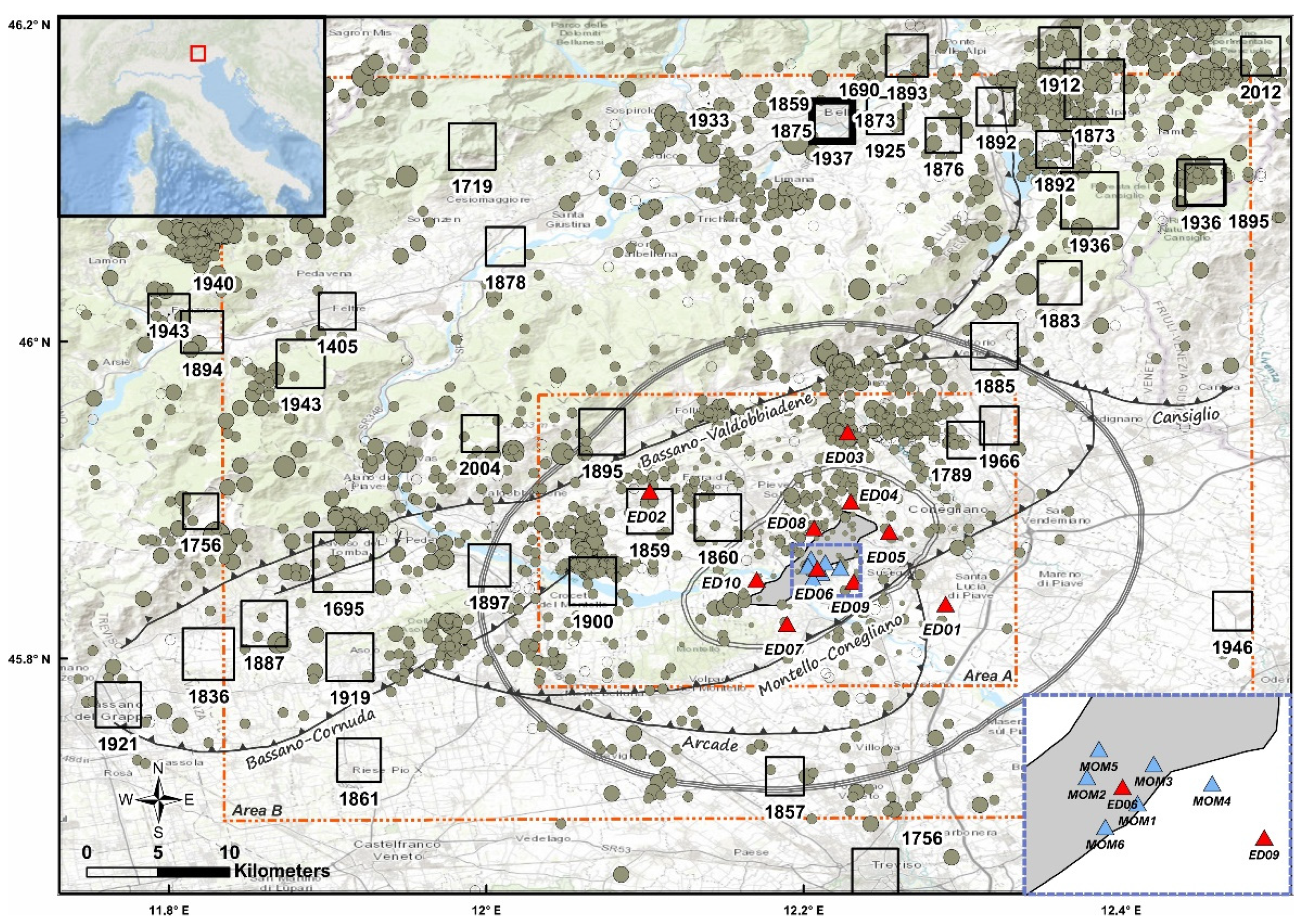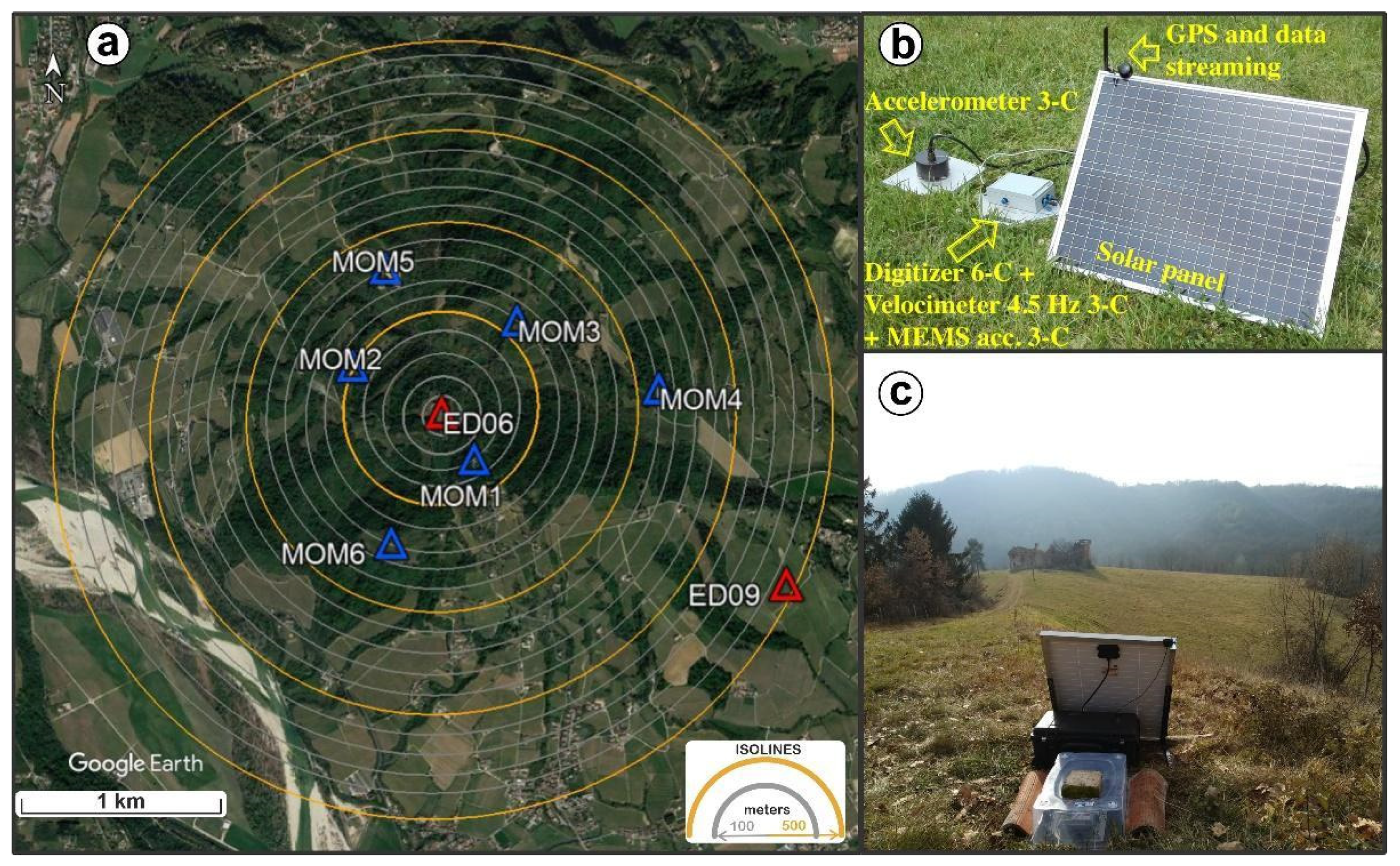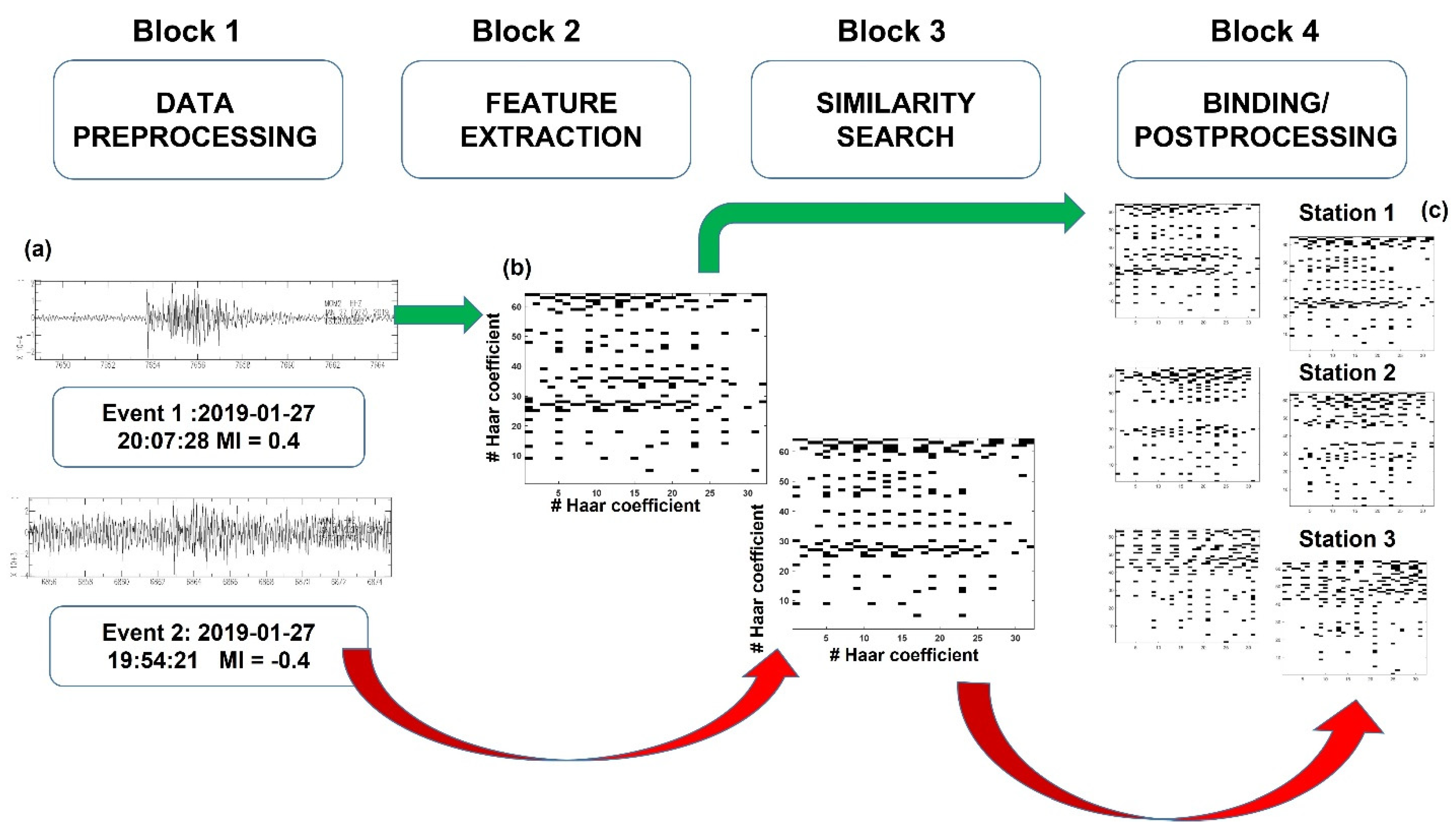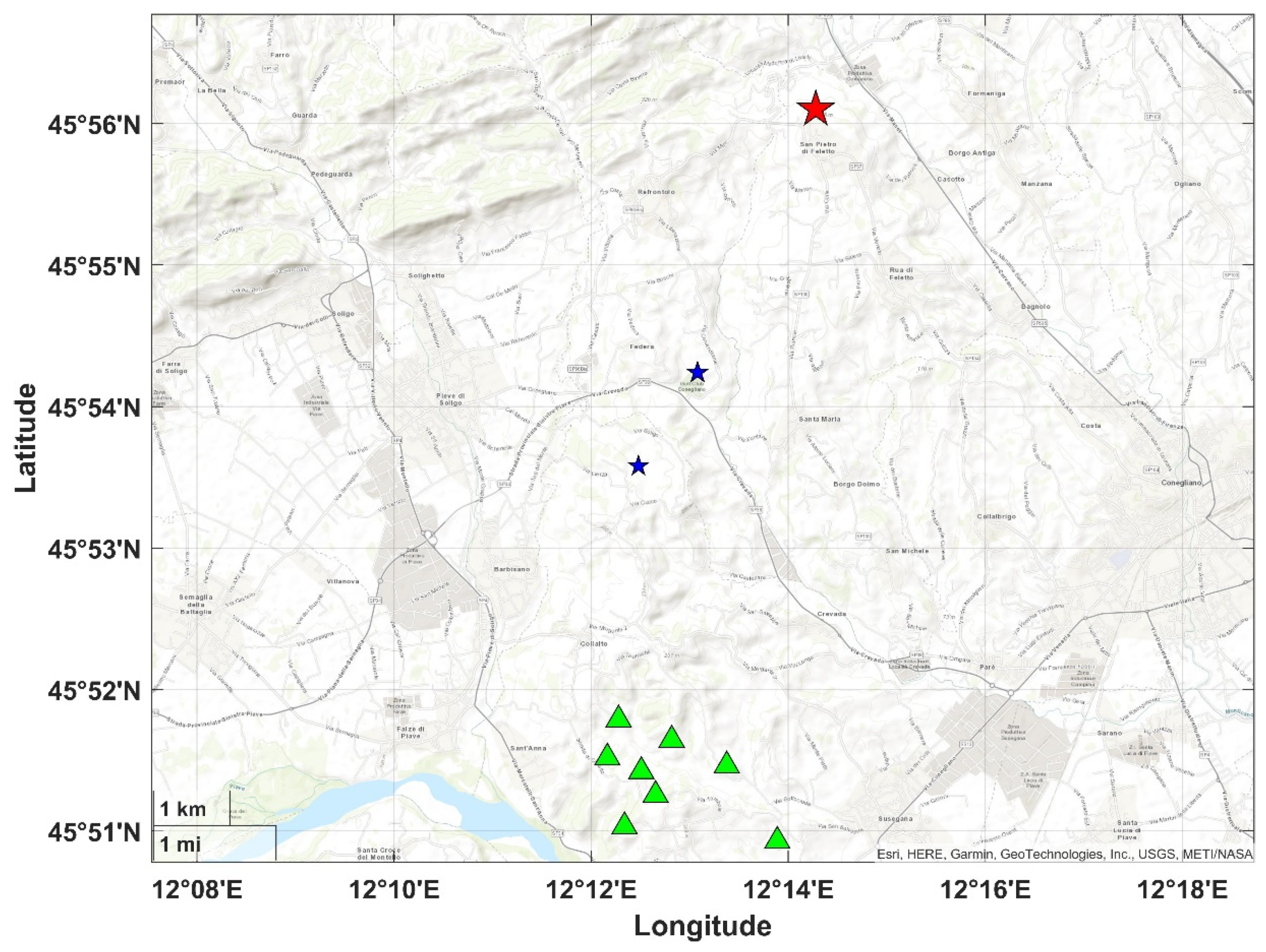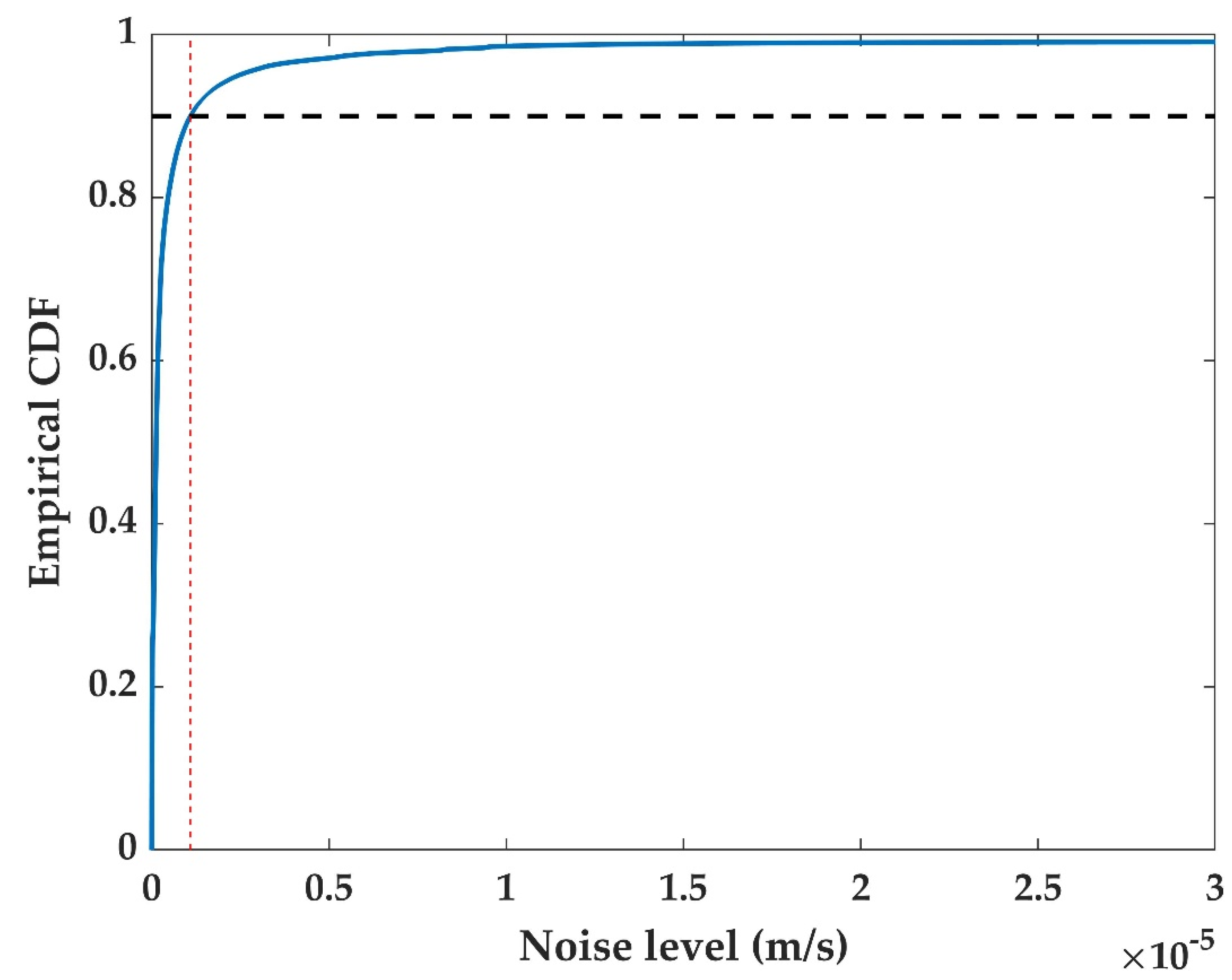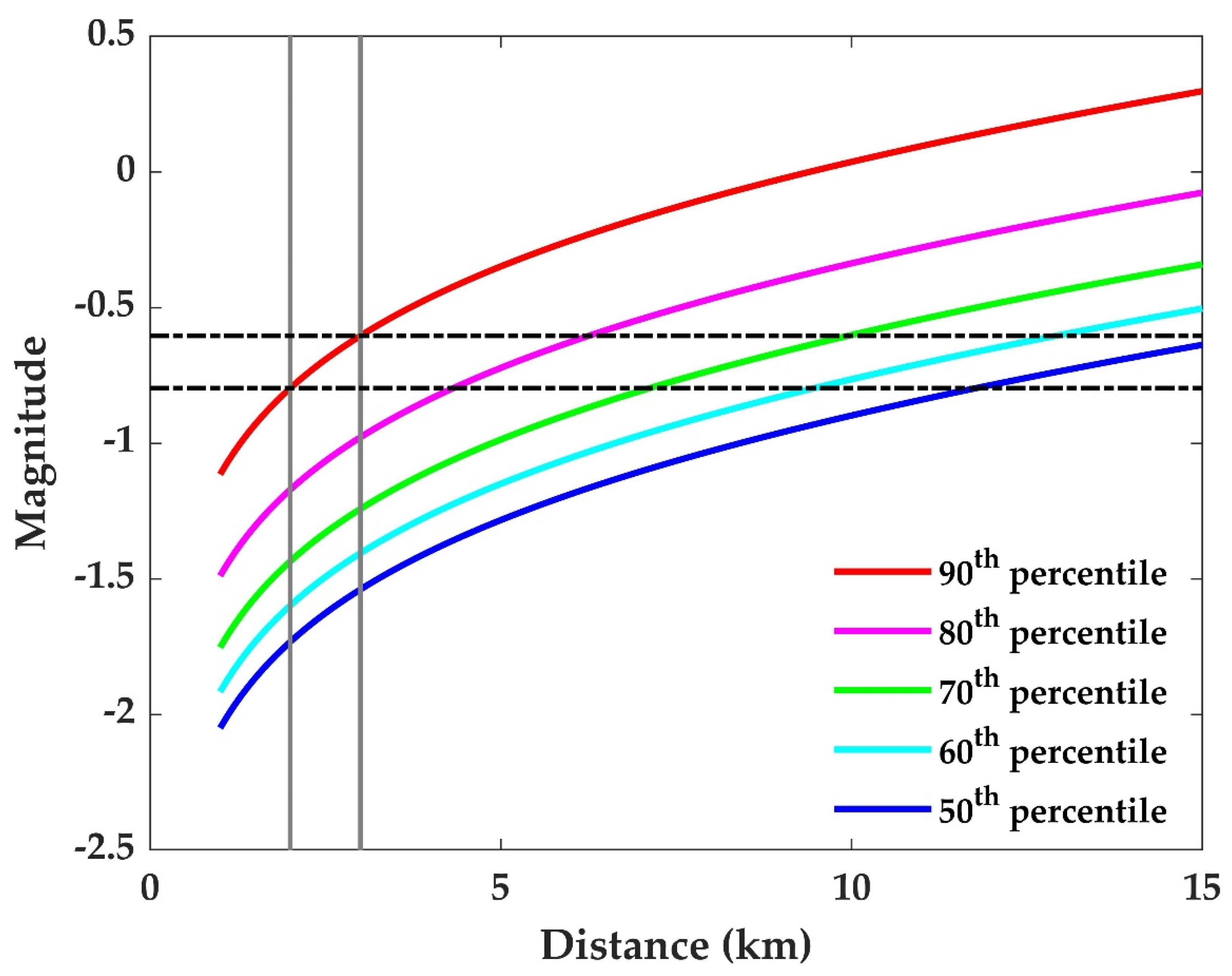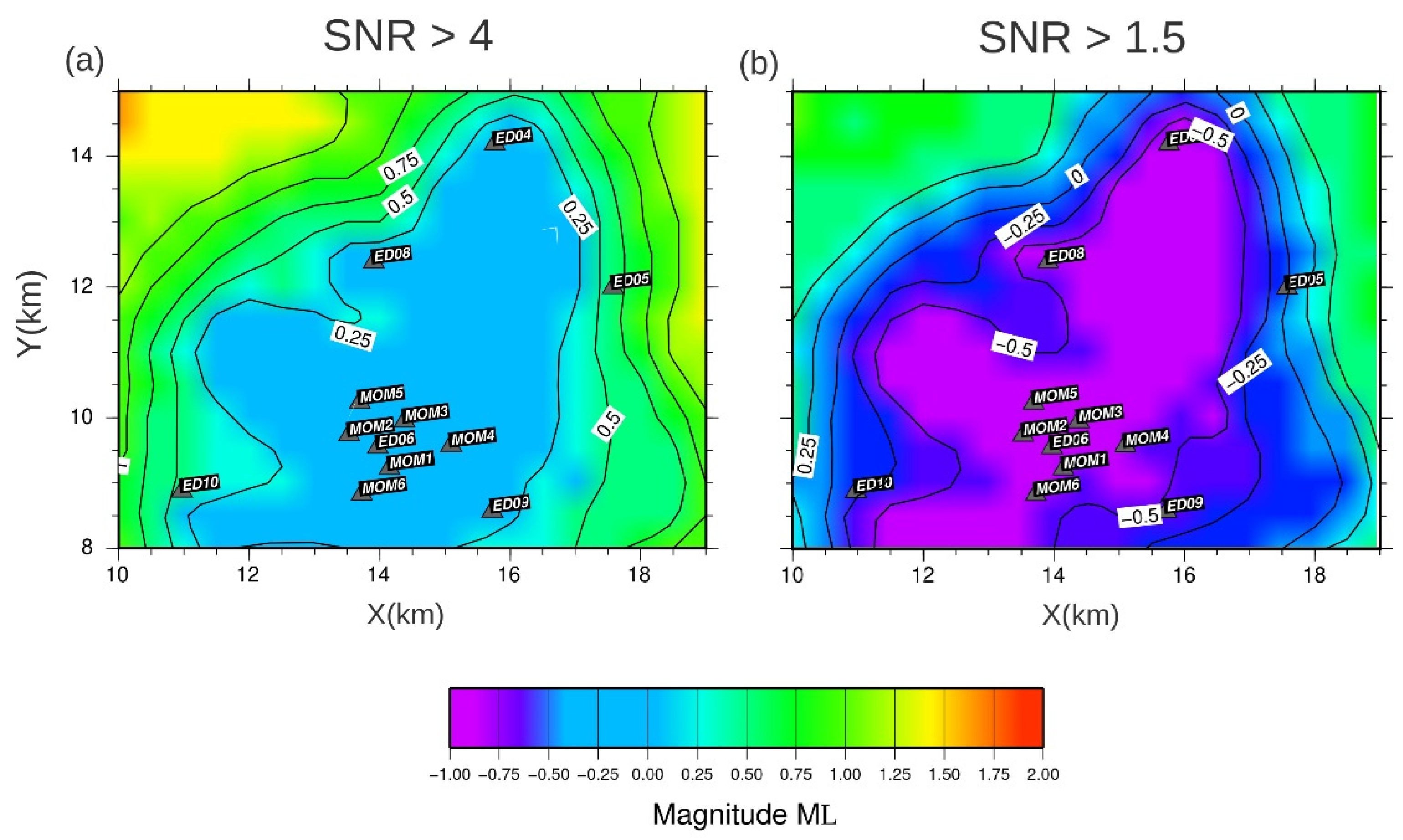1. Introduction
Monitoring the seismicity in areas of underground hydrocarbon exploitation and fluid injection and storage is a crucial task considering the significant socio-economic implications in case of induced earthquakes [
1]. Seismic monitoring aims to characterize the spatio-temporal evolution of the seismicity in a sub-surface volume where industrial exploitation activities take place with the two following goals: (i) discriminating the natural seismicity from the anthropogenic one (i.e., induced), (ii) intercepting variations in the background seismicity rate that, if needed, will guide the re-modulation, interruption, and restart of industrial activities. Indeed, tracking the microseismicity in time after fluid injection and accurately locating it can allow one to detect pore pressure changes and intercept migration fluid patterns [
2].
An exhaustive review of concepts, methods, and physical bases concerning the monitoring of induced seismicity, possibly deploying small aperture seismic arrays, is provided by [
3] and references therein. In this framework, [
4] realized a feasibility study for seismic networks aiming to monitor the induced seismicity according to the performance requirements in the Italian guidelines [
5]. Such a study considered several network layouts, with different geometries and station densities, also including the use of seismic arrays with a maximum aperture size of 1 km. The results indicate that, for low noise levels, integrating seismic networks with small-scale arrays can achieve a magnitude detection threshold close to Mw 0 and small location errors (i.e., a few hundred meters for depths down to 8 km).
For this reason, during the last years, efforts from the seismological community have focused on the development of cost-effective seismic sensors that can be combined with high-quality observing systems. Furthermore, efforts have been made in the application of innovative data mining strategies for improving the detection capability.
An example of a high-sensitivity network is the one deployed around the Collalto underground gas storage (UGS) in north-eastern Italy [
6]. The Collalto seismic network (Rete Sismica di Collalto, RSC) aims at monitoring the natural and induced seismicity potentially related to the industrial activity of the Collalto gas storage facility. It is composed of ten seismological stations equipped with borehole seismometers with periods varying between 10 s and 120 s operating at a sampling rate of 200 Hz, and accelerometric sensors at the surface of five sites. This network is managed by Istituto Nazionale di Oceanografia e di Geofisica Sperimentale (OGS) on behalf of Edison Stoccaggio S.p.A., which is the holder of the storage concession, and it has been the first case of industrial seismic monitoring in Italy managed by a public research institute. The RSC has been fully operating since the 1 January 2012, and it represented an important experience for the Italian guidelines for monitoring the industrial activities associated with underground resource exploitation, which were developed after the destructive earthquake that struck the Emilia region in 2012 [
5]. The OGS guarantees the seismic (real-time and off-line) monitoring and network maintenance service, as well as any related research activity, delivering full data and transparent information through the RSC website (rete-collalto.crs.inogs.it). Publicly available data include full waveform data and the earthquake catalog, which is updated every six months. More details about the network deployment and features can be found in [
6].
The Collalto gas field is a natural, depleted reservoir with a working gas storage capacity of approximately 600 million standard m
3 (total capacity of more than 900 million standard m
3) covering an area of almost 89 km
2 [
7]. The field is equipped with 17 active wells through which the gas is seasonally injected into the reservoir during the April–October period and extracted during the November–March period [
6,
8]. In ten years of operation, the Collalto seismic network recorded thousands of microearthquakes of natural origin in the surrounding areas, reaching a completeness magnitude Mc for the whole area of 0.6 and 1.2 for the local [
8] and moment [
9] magnitude, respectively, and of 0.1 for a smaller region around the reservoir [
10]. The ten-year long monitoring highlighted that no events occurred close to the gas-reservoir and no clear correlation exists between seismicity in a broader area and the injection and extraction activity [
8].
The efficiency of seismic monitoring can be further enhanced by data mining approaches, capable of enriching earthquake catalogs, lowering the Mc threshold near to 0 or below, and hence allowing to better investigate the mechanical features of the spatio-temporal seismicity evolution. Most of these methods [
11,
12,
13,
14] are generally referred to as template matching. They detect micro-events within a continuous data stream through cross-correlation of the waveforms associated with some previously identified earthquakes. As an example of the efficiency of this approach, [
15] retrieved an extended catalog of ~3500 earthquakes for the 2013 induced seismic sequence at the Castor injection platform offshore Spain, which includes three earthquakes of magnitude 4.1. This final catalog significantly improved the official IGN and Ebro catalogs, reporting 536 and 982 earthquakes respectively. Thanks to this catalog [
15], the authors were able to study the progressive fault failure and unlocking, triggered by pore pressure diffusion and characterized by the migration of seismicity away from the injection point. Moreover, the detection through the recognition of some peculiar seismic waveform features is now being developed increasingly by means of advanced deep learning algorithms [
16].
A similarity search can be carried out also without the use of template events, using auto-correlation techniques that correlate different portions of the continuous data stream [
17,
18,
19,
20,
21]. These methods are particularly efficient in areas characterized by a low level of seismicity with few events available in seismic catalogs. Nevertheless, the computational costs are much more expensive due to the need for mutual comparison between all data portions. The FAST technique (fingerprinting and similarity thresholding [
22,
23]) represents an optimized auto-correlation approach, based on the compression of waveforms in key discriminative features, using binary fingerprints, and the a priori grouping of similar fingerprints to reduce the order of magnitude of the performed comparisons. The FAST technique playback on the Hector Mine earthquake (1999, Mw 7.1, [
24]) revealed an intense foreshock sequence with 50 detected events with a minimum magnitude of −0.4. Recently, the same approach was applied to the Southern Italy, Rocca San Felice sequence (3–6 July 2020, maximum magnitude Ml = 3.0), allowing to increase by a factor of 10 the number of detected events while lowering by about 1 point in magnitude the completeness threshold when compared to the released Irpinia Seismic Network catalog [
25,
26].
A comparison between the FAST technique and a standard template matching approach [
27] has been recently proposed for a very active seismic sequence (~14 k events in three months), potentially induced by wastewater injection, that occurred in Arkansas, USA in 2010 [
28]. In this work, the authors showed that the two approaches lead to similar results in terms of detections. Although the large number of templates allows the template matching to slightly overperform, the events only detected by FAST are characterized by smaller average magnitude values.
In this work, we aim to show how and to what extent a small aperture, low-cost seismic array combined with an advanced microseismicity detection technique can locally improve, e.g., in terms of magnitude of completeness, the performance of a permanent, high-quality, less-dense seismic network, enhancing the local earthquake catalog. We used the data collected during an experiment that integrated the array monitoring system for induced seismicity application, proposed by [
4], with the data mining approach implemented in the FAST technique. For this purpose, the installed array, with a 2 km maximum aperture, was composed of eight seismic stations located in the area near the gas storage site in Collalto. The temporary network was installed in wintertime and was operative for about one month.
We first describe the geology of the investigated area. Then, we provide details about the experimental and methodological setup. Second, the results relevant to the number of detected events and their features will be presented and discussed. Finally, conclusions are presented.
3. Detection Technique
To detect micro-earthquakes at the level of the seismic noise, we applied the FAST technique (fingerprint and similarity thresholding,
https://github.com/stanford-futuredata/FAST [
22] accessed on 10 July 2020) to the 25 days (from 7 to 31 January 2019) of the continuous velocity data stream recorded during the experiment.
FAST is a uninformed self-similarity technique that converts time-domain waveforms into fingerprints, containing key discriminative features of earthquakes, and then performs an optimized similarity search to individuate couples of similar fingerprints. FAST features good performances both in computational efficiency and in detection sensitivity since it can reach the accuracy of autocorrelation methods while requiring lower runtime [
22,
23]. The advantage of using FAST is that it does not require templates to search for similar events. Hence, it is particularly efficient in areas characterized by low seismicity, such as the gas-storage area of Collalto considered in this study.
The FAST workflow consists of four steps: (a) data pre-processing; (b) feature extraction, in which time series are compressed into binary fingerprints; (c) similarity search, with similar fingerprints gathered in a database; (d) network association, where single station detections are bound, and post-process analysis, where false events are discarded and the magnitude of the detected earthquakes is estimated.
In the pre-processing phase (Block 1 in the workflow of
Figure 3), gaps and zero in the data stream are replaced with Gaussian uncorrelated noise. Moreover, the signal at all the stations is bandpass filtered between 1 and 20 Hz using a 2-poles acausal Butterworth filter and decimated to 50 Hz to dump the high frequency noise and improve computational efficiency.
In the feature extraction phase (Block 2 in
Figure 3), 12.4 s long signals from single components are converted into spectrograms where each spectrum is built for 6.0 s of signal with a shift of 0.2 s, and the frequency range 1–20 Hz is subdivided in 32 equally spaced bins. The resulting spectrogram has 32 × 32 samples. Two consecutive spectrograms are shifted in time with a lag of 1.0 s [
22]. Each spectrogram is then compressed applying the Haar wavelet transform and maintaining only the 200 out of 1024 coefficients that most detach from their daily average. This compression is shown to preserve the seismic features in the fingerprints under the assumption that the daily average is representative of the ambient noise. The selected coefficients are then binarized, following the scheme of [
22] to generate final fingerprints, each consisting of 2048 bits.
In the similarity search step (Block 3 of
Figure 3), FAST uses the Jaccard similarity to compare the fingerprints. Such a comparison is reduced to a limited number of fingerprint characteristics extracted through the application of a Min-Hash independent permutation algorithm [
38]. In the bottom panels (a) and (b) of
Figure 3 waveforms from two events (14 and 15 in
Table 1) and the associated fingerprints are plotted. The shown fingerprints are characterized by a high Jaccard similarity, and hence will be inspected at following steps for event declaration.
The fingerprint pairs extracted at component level are combined and associated at the network level, allowing time delays compatible with the wave propagation within the network (
Figure 3 Block 4 and panel c). At this stage, we select transients only if their similarity is retrieved at least at 4 stations. Since one of the main issues when applying FAST trying to reduce its detection reliability is the large number of false declared events [
24,
28], the transient list is further investigated in terms of first arrival times and duration. For the Collalto array, several candidate events forming a family of candidate events were removed because of low apparent velocity across the array, long duration, and almost monochromatic character. These characteristics let us guess that such transients were related to anthropic activity and/or weather effects. Finally, local earthquakes from regional and teleseismic events separation is carried out according to the transients’ duration. After this last step, the catalog was further enhanced, including all the transients associated at less than 4 stations but being similar at least at 2 stations. The final catalog provided by FAST is a detection list without locations. Some of the detected events are reported in the RSC catalog for the larger events (hereinafter, reference events). This information concerning the reference events is used, hence, to assume that smaller events featuring low signal-to-noise ratio and belonging to the same family of the larger ones are co-located with them.
For those small events that were declared similar to an event included in the RSC catalog, we computed the magnitude of these latter events as:
where
is the maximum peak-to-peak displacement amplitude on the non-filtered horizontal components of the target event while
and
are the magnitude and the maximum peak-to-peak displacement amplitude of the reference event, respectively. The magnitude values obtained at the stations where FAST declared the similarity are then averaged to obtain the final estimation.
4. Results
We applied the analysis described in
Section 3 and detected 38 transients. Among them, 20 transients were discarded during the post-processing association phase due to unrealistic apparent velocity within the array. Indeed, they are characterized by signals having short durations (
) and a large difference between the arrival times at the different array nodes (
). To verify algorithm performance, we visually inspected them, and we confirmed that these waveforms were not seismic signals being characterized by either monochromatic wave trains or the superposition of two monochromatic components at close frequencies. At the end of the analysis, we obtained a list of 18 detections. These findings confirm that the implemented procedure overcomes the FAST limitation concerning the discrimination between real and false events for the array experimental setup.
It is worthwhile to highlight that, during the experiment, a seismic sequence occurred in the district of Ravenna, at an epicentral distance of about 230 km from the array centre, with the largest event having magnitude Mw 4.3. Inspecting the detected events, FAST declared five different transients that can be associated with three events of this sequence. The number of transients (5) is larger than the number of associated events (3) since two events were detected twice (FAST separately declared body-waves and later surface waves).
Our final catalog is composed of 16 seismic events (
Table 1). These events are ordered according to their origin time, and with the associated location and magnitude as extracted from the INGV or the RCS catalog, when available. The last column of
Table 1 indicates the events, to which FAST declared the similarity.
We recognize seven local events that occurred in the area of Collalto, while the remaining ones are regional or teleseismic events.
Concerning the local events, we found two detections located close to Conegliano (ev. 09–10 in
Table 1, blue stars in
Figure 4,
Figure S4c,d in Supplementary Material). These latter were the closest earthquakes to the array that occurred during the experiment, according to the RCS catalog, with magnitude Ml 0.1 and Ml 0.0 respectively. Another two events were detected by FAST (ev. 03–04 in
Table 1,
Figure S4a,b in the Supplementary Material) and not reported in the catalog. These events were declared because of their reciprocal similarity and their similarity with ev. 09. They feature a very low signal-to-noise ratio (SNR~1.5) and cannot be located using the array records. However, considering that their waveforms are very similar with those of the ev. 09, we assumed these events co-located and provided an estimate of the magnitude (Ml −0.4 and −0.2 respectively) as the average magnitude value computed by applying Equation (1) at all the stations where the events were declared. In the following, we will discuss the performance of FAST in terms of minimum detectable magnitude in the area close to the Collalto gas storage area and the meaning of the local magnitude scale for such small events.
In addition, FAST correctly also identified the Ml 0.4 event located at Vittorio Veneto (ev. 15 in
Table 1, red star in
Figure 4), which was also included in the RCS catalog, and two further events (ev. 13–14,
Figure S5 in the Supplementary Material) similar to it. Also in this case, the magnitude was estimated through the amplitude ratio (Equation (1)) considering the ev. 15 as a reference.
It is worth noting that the negative magnitude events of Conegliano (ev. 03–04 in
Table 1) and Vittorio Veneto (ev. 13–14 in
Table 1) anticipated the corresponding larger-magnitude events. In particular, events 03 and 04 occurred ~15.5 and ~14 h before event 09, while events 13 and 14 were detected ~6.5 h and ~13 min before the origin time of event 15. We finally highlight that for the whole period of our experiment, no events located in the close vicinity of the array and gas-storage were detected.
5. Discussion
The similarity search results do not report any detected earthquake near the gas storage during the experiment. Nevertheless, the procedure allowed us to detect seven events a few kilometers from the array deployment to the north, four of which represent new events. For the new detections, we exploited their high similarity to some larger-magnitude events, so that we could co-locate the new small events with the corresponding parents and estimated their magnitude, which resulted to be negative. Despite the small number of these new events, we can interpret them as foreshocks of the two larger-magnitude reference events. According to [
39], who observed foreshocks before small magnitude events in Central Alaska, a systematic observation of foreshocks associated with small magnitude events for long periods could help to investigate the continuity and complexity of slip processes occurring in a specific area. Our results, hence, suggest that the integration of seismic networks and seismic arrays over long periods, combined with advanced data analysis strategies, could help to shed light on important questions concerning earthquake nucleation.
The limited duration of our experiment did not allow us to fully estimate the capability of the full permanent and temporary deployment in monitoring the micro-seismicity with respect to the storage area target. However, starting from our results, in the following, we propose a strategy to (i) infer the smallest magnitude that could have been detected in the study area; (ii) confirm, within a fixed level of confidence, that no events above a certain level of magnitude occurred in the gas-storage area during the experiment period.
To estimate the minimum magnitude that could have been detected in the storage area, we investigate the noise distribution in the waveforms processed through the similarity search of FAST. For this study, the data stream at all stations of the array was subdivided into one-minute-long windows and then filtered in the band 1–20 Hz, similarly to the pre-processing phase described in
Section 3. Within each window, the level of noise was estimated as the RMS of the whole signal.
Figure 5 shows the empirical cumulative distribution of the noise along with the level corresponding to the 90th percentile, that is
.
For local events detected by FAST, we computed the signal-to-noise ratio (
SNR) on the horizontal components of the stations associated by FAST. Considering 7 s-long windows before and after the origin time as the noise
and the signal
contributions, we computed the Fourier transforms of both time series
and
. The
writes as:
where
and
. For the three largest events of the two clusters (ev. 9, 10 and 15 in
Table 1),
SNR ranges between 4 and 6 at all the horizontal components of the stations of the array, while for the smallest ones (ev. 3, 4, 13 and 14 in
Table 1)
SNR ranges between 1.01 and 1.67 with a mean value
. We can consider this mean value as an estimate of the limit for the detection capability of the array system processed by FAST. Around this
level, we have detected events of minimum magnitude M = −0.4 at a maximum hypocentral distance
R = 13 km. Fixing this
SNR level and reducing the distance in the range between 2 km and 3 km, to account for events potentially occurring near the gas-storage area, we can estimate the minimum detectable magnitude using the local magnitude scaling law proposed by [
40] and valid for north-eastern Italy:
with
Ml local magnitude,
,
,
r the distance (in km),
,
the local station coefficient, which is assumed zero, and
the Wood-Anderson displacement maximum amplitude. To estimate the limit magnitude detectable around the array deployment, considering the overall level of noise and the estimated quantity
, we replace the amplitude term in Equation (3) with the following quantity:
with
the Wood-Anderson amplitude of the nth percentile of the noise distribution (see
Figure 5). Equations (3) and (4) enable the magnitude estimate for a local event located at a generic distance
, generating an amplitude emerging from a fixed level of noise with a prescribed
level. The higher the percentile, the more our estimate represents a good proxy for the magnitude of completeness of the system.
The results of this analysis using a value of
for computing Equations (3) and (4) are shown in
Figure 6 for different percentile values of the noise amplitude. Considering that the Collalto gas-storage has an average depth of 1.5–1.6 km, and taking into account a range of reference distances between 2 km and 3 km from the array stations, we have retrieved an average limit magnitude
between −0.8 and −0.6 when we select a noise level equal to the 90th percentile of the noise distribution. Thus, we can state, with a 90% level of confidence, that no events with local magnitude larger than −0.6 have occurred within the study area during the experiment. It is worthwhile to notice that in the case of very intense seismic activity, the expected detection accuracy of FAST was shown to be comparable to one of the more common template matching approaches, and that the combined use of both techniques might further increase the detection capability [
28]. However, the low level of seismicity in the area under study in this work, with no available waveform templates for events within the reservoir and very low
SNRs for the smallest events in the final catalog, seem to confirm that relying on FAST is the near-optimal choice for the presented application.
All the estimated magnitudes presented here are local magnitudes derived from the regional scaling presented in [
40]. The values discussed in this study are small and well below the limit for which the local magnitude
can be estimated without systematic bias. (e.g., [
9,
41]). This is due to the restriction of the exploitable frequency range for the analysis, determined by the sampling rate generally adopted by the networks (low compared to frequency content of the micro earthquakes), the signal to noise ratio and the combined effect of the anelastic and scattering attenuation [
42,
43]. This implies that any interpretation of the local magnitude in terms of seismic moment should be treated with caution. Indeed, when decreasing the magnitude, the corner frequency is above the Nyquist frequency, providing a theoretically faster scaling for the local magnitude than for larger earthquakes [
43].
To provide a theoretical interpretation of the results and estimate to what extent the improvement is due to the proposed seismic array technique, we followed the approach of [
4]. Considering the seismic noise conditions observed during the experiment, we evaluated the expected detection capability of the Collalto standard network integrated with the seismic array for events at 2.5 km depth. For the simulation, we have considered the scenario composed by the Collalto seismic network integrated with the array, the noise level evaluated in this study (~10
−6 m/s), and the 1D local velocity derived for the area [
44,
45].
Figure 7a shows that, for an area of 2–3 km around the reservoir, the minimum expected detectable magnitude is approximately 0.0. It is worthwhile noting that the detection threshold adopted in this analysis is estimated by considering a standard detection technique based on STA/LTA requiring a SNR > 4 for at least three S-wave phases. Concerning these detection criteria, we observe no significant improvement of the RSC magnitude of completeness, obtained from visual waveform inspection [
10]. When using the same waveform similarity criteria as adopted for FAST processing and a threshold of SNR > 1.5, the expected magnitude of completeness improved to −0.7, consistent with the
estimated above. In this framework, the main contribution of a dense seismic array placed in the close vicinity of the gas storage area is to increase the number of stations where the minimum needed
SNR is achieved.
In conclusion, taking into account all the described limitations, our findings suggest that the empirical estimation presented in
Figure 6 is a good proxy of the magnitude of completeness of the experimental system and that, in this configuration, most of the improvement results from the application of an efficient detection algorithm based on similarity-search, which allows us to catch events with amplitude comparable to the noise level. Hence, in a future perspective, a longer installation of the presented monitoring setup might unveil whether ultra-micro earthquakes (M < 0) actually occur around the reservoir area and, possibly, if they can be correlated to the gas-storage activity.
6. Conclusions
This work concerns a monitoring experiment carried out in the monitoring area of the Collalto gas-storage in the North-East of Italy. Here, we installed a seismic array with a radius smaller than 2 km and analysed continuous velocity data acquired for 25 days during wintertime through the application of the optimized auto-similarity search technique FAST. The array monitoring system was conceived as a low-cost system, aimed at integrating the permanent high-resolution Collalto Seismic Network (Rete Sismica Collalto, RSC) right in the center of the monitoring network.
FAST was able to detect all the small events included in the RSC earthquake catalog and occurred just outside the gas-storage area, within a distance of 15 km from the array. These events were very small, and their magnitude was in the range 0.0–0.4, very close to the magnitude of completeness of the RSC network. FAST was also able to detect four more events, all with negative magnitude and not reported in the RSC catalog, which occurred a few hours before the reference events. Instead, no events were detected right below the array or the gas storage area.
To infer the detection capability of the system, in terms of magnitude of completeness, we first defined a proxy for the minimum
SNR, enabling the detection by estimating the overall distribution of the signal-to-noise ratio for the smallest detected events throughout the array. This
SNR threshold resulted, on average, equal to 1.34, revealing that the system was able to detect a micro-earthquake whose signals were fully buried in the noise. The overall noise amplitude distribution and the minimum
SNR estimates were in turn used to quantify the minimum magnitude that could be detected for events occurring in the gas-storage area. Exploiting the magnitude law proposed for North-East Italy by [
40], and considering the 90th percentile of the noise distribution, the limit magnitude of detectable events ranges between −0.8 and −0.6. Thus, we can also reasonably guess that no events with
Ml > −0.6 occurred during the experiment within the gas-storage area. These findings are consistent with the theoretical model proposed by [
4], which indicates that most of the improvement is due to the application of an advanced data mining strategy enabling the detection of events even with very low
SNR.
